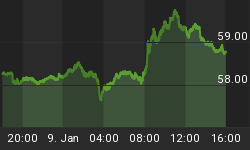Here is an extract from commentary posted at www.speculative-investor.com on20th November 2003:
The fundamental case against the US$ has been discussed at length in TSI commentaries over the past three years. In summary, though, the main driver of the dollars bear market is the massive -- and still increasing -- US current account deficit.
In order for the dollar NOT to fall the US needs to attract sufficient foreign investment every month to offset the current account deficit. Therefore, given that US-based investments are unlikely to offer superior returns to investments in other parts of the world for many years to come it is highly probable that the dollar's downward trend will continue until the quarterly current account deficit is eliminated. At this stage there hasn't been any reduction in this deficit so the dollar's bear market is clearly still young.
The current account deficit, combined with the likelihood of dollar-denominated investments providing sub-par returns for many years to come, would be enough to make us very bearish on the US$. However, another major risk for the dollar has emerged over the past year. That risk is the Fed's absurd plan to keep short-term interest rates near multi-decade lows for a considerable period of time in order to combat an imaginary deflation threat. If Greenspan and Co. follow this plan for another 6-12 months, as they have intimated they will, then the dollar's decline will accelerate.
Our view, however, is that the markets will not allow the Fed to follow this plan beyond the next few months. In fact, we've forecast that rising long-term interest rates will cause the Fed to a) switch to a tightening bias by January of next year, b) make its first rate hike by March, and c) be hiking rates aggressively by mid-year. The main risk, as far as this view is concerned, is that foreign central bank buying of US Treasury and Agency debt will be sufficient, for several more months, to prevent the bond market from signaling the inflation problem. If this were to happen then the Fed would have the option of leaving short-term rates near their current low levels for a longer period and the US$ would most likely get where it is going much faster than we currently expect.
Where is the US$ going?
The below long-term chart, which we've included a few times in past commentaries and which shows the number of US dollars per Swiss Franc, defines our long-term expectations for the US$. The chart shows that:
a) The SF has been in an upward trend against the US$ since the early 1970s
b) Within the SF's long-term upward trend their have been two SF bear markets (US$ bull markets) lasting 6 years that have ended at the long-term channel bottom and two completed SF bull markets lasting 8-10 years that have ended at the long-term channel top.
If the current Swiss Franc bull market roughly matches the previous two bull markets in terms of magnitude and duration then it will end in 2008-2010 with the SF/US$ rate slightly north of 1 (30-40% above the current level).

Our current expectation is that the SF will work its way to the channel top over the next 5 years or so. However, the Fed's determination to hold short-term interest rates at such a low level for a long time to come creates a risk that the SF will surge through to the channel top over a much shorter period. Note that during the mid-1980s -- a period during which the dollar's fundamentals were not as bearish as they are now -- it only took the SF three years to go from its channel bottom to its channel top. It then spent much of the next 5 years in the top one-third of its long-term channel.
The key, as far as whether the Fed will be allowed to be stupid enough to hold rates near current low levels for another 6-12 months, is the bond market. If bond prices tank then the Fed will be forced to hike short-term rates because not doing so would cause a disaster in the stock and property markets. However, if something is able to prevent bonds from tanking then the Fed will have the option of not hiking short-term rates (assuming it is prepared to tolerate a huge decline in the US$).
So, what might prevent long-term rates from moving sharply higher?
As explained in our 17th November commentary the Fed can't force long-term rates lower by buying bonds because any Fed purchases would, by definition, be inflationary (such purchases would be made with newly-created money). The only things we can think of that would have any hope of working are the re-emergence of deflation fears due to extreme weakness in the stock market and/or an acceleration in the rate at which foreign central banks purchase US debt.















